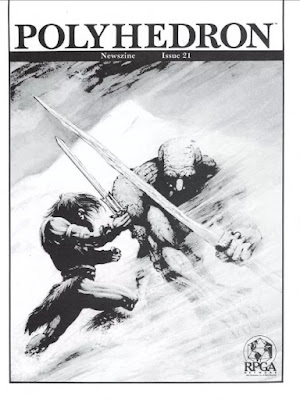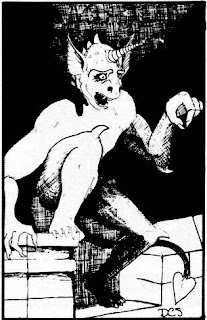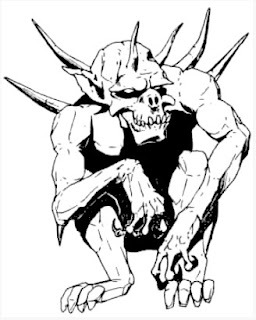Polyhedron: Issue #21
 Issue #21 of Polyhedron (January 1985) features a cover illustration by Timothy Truman, who produced a lot of artwork for TSR throughout the 1980s before going on to greater success as a comic book artist. The piece depicts the protagonist of this issue's "Encounters" article, facing off against a creature of para-elemental ice, but, as I'll explain shortly, I have some questions.
Issue #21 of Polyhedron (January 1985) features a cover illustration by Timothy Truman, who produced a lot of artwork for TSR throughout the 1980s before going on to greater success as a comic book artist. The piece depicts the protagonist of this issue's "Encounters" article, facing off against a creature of para-elemental ice, but, as I'll explain shortly, I have some questions.
The issue starts with another "Notes from HQ" article by Penny Petticord. Her position is RPGA Network Coordinator, which I assume is the title of the head of the RPGA. However, starting with issue #22, Petticord will also be the editor of Polyhedron, taking over from Mary Kirchoff, who'd been on the staff of the newszine since issue #5. She would then devote herself full-time to fiction, writing numerous Dragonlance novels and later becoming part of TSR's book publishing division.
Next up is the aforementioned "Encounters" article by James M. Ward. The scenario sees a young paladin named Ren Grakkan on a quest to retrieve "the most potent of all artifacts," the white cloak of enchanting (or is it charming? The text is inconsistent) for his unnamed lady love. The cloak is found in a cave guarded by para-elemental ice monsters. As I noted, I have a couple of questions. First, Ren is described as a paladin, but he looks more like a classic sword-and-sorcery barbarian based on Truman's illustration. The text at least supports this, since he's described as wearing no armor but only bracers of defense (AC 4) and having Dexterity 18 (hence a –4 defensive adjustment). Even so, he looks nothing like what I'd expect of a "paladin," but perhaps I simply lack imagination. (I suppose it's possible the artwork depicts the cloak's original owner, a barbarian lord, who lost it in battle against the ice creatures, but then why isn't the cloak shown?) Second, this so-called "potent artifact" Ren is seeking makes its wearer's charm and illusion spells harder to resist, especially if the wearer is female. Could it be that Ren's "lady love" is actually a sorceresss who's charmed him? There's no evidence of this in the text, but the thought occurs to me. (Also, why does Ward keep re-using the name "Ren" for his characters?)
Sonny Scott's "Observations from a Veteran Gamer" is short piece of fluffy advice from a long-time player of AD&D who's also a stalwart of the RPGA. I don't mean to be so dismissive, but there's nothing here you've never heard a thousand times before. More interesting is Gary Gygax's "Why Gargoyles Don't Have Wings But Should." The article begins with classic Gygaxian boasting: he speaks of his association with Flint Dille ("Did you know his grandfather invented Buck Rogers?") and their upcoming joint projects. Then, he moves on to his dissatisfaction with depictions of both the gargoyle and the mar(l)goyle from Monster Manual II. The illustrations for both, Gygax says, lack wings and this should be corrected in "some future edition" of AD&D. For reference, here are the two illustrations in question:
 "Don't try to tell me those dark shadows are wings!" Thus spake Gygax.
"Don't try to tell me those dark shadows are wings!" Thus spake Gygax. Gygax also explains that the second monster's proper name is marlgoyle, with an "l," just as it's named in The Lost Caverns of Tsojcanth. This is one of those cases where, if one knows anything about geology, the error is obvious. In any case, I find this sort of thing fascinating – all the more so because the error was never corrected in any subsequent edition of the game.
Gygax also explains that the second monster's proper name is marlgoyle, with an "l," just as it's named in The Lost Caverns of Tsojcanth. This is one of those cases where, if one knows anything about geology, the error is obvious. In any case, I find this sort of thing fascinating – all the more so because the error was never corrected in any subsequent edition of the game. Roger E. Moore's "Take Command of a Titan!" is, by far and away, the best part of this issue and indeed one of my favorite articles ever to appear in any gaming periodical, not simply Polyhedron. In it, Moore lays the groundwork for a "Big Ship" campaign in Star Frontiers. By "big ship," he means a space vessel whose crew numbers in the hundreds at least, if not more. This is territory well covered by both Traveller and Star Trek, but it's not really discussed in Star Frontiers. Additionally, Moore provides lots of ideas on what makes a Big Ship campaign unique and fun. Back in my youth, this article, along with its sequel in the next issue, was a very inspirational one for me. To this day, I find myself longing for a science fiction campaign set aboard a Big Ship.
"Spelling Bee" by Frank Mentzer returns, looking at the ins and outs of a few low-level magic-user spells for AD&D. I'm always of two minds about these kinds of articles. On the one hand, I appreciate seeing the clever ways that people can make use of well-worn spells. On the other hand, some of these clever uses depend on very specific, nitpicky, and possibly tendentious readings of the text. It's a fine line, to be sure, which is why I can't be outright dismissive of articles like this, even as I, as a habitual referee, tend to grit my teeth at some of the more "creative" applications put forward.
"Witchstone" by Carl Sargent is an AD&D adventure for character levels 8–12. It's an odd adventure, because, at base, it's pretty mundane: a bunch of hill giants are causing trouble and it's up to the PCs to deal with them. However, the reason why the giants are more hostile than usual concerns a power play by a giantess wishing to make her son chief. This she does by trickery, pretending she is a witch and arranging for "accidents" to occur that support her false claim. It's certainly interesting in an abstract sense, but I'm not sure how much of this would be communicated to the characters involved in the adventure.
"Five New NPCs" is just what its title suggests: a collection of five non-player characters submitted by RPGA members. None of them are especially memorable. "Module Building from A to Z" by Roger E. Moore is vastly more worthy of attention. In this lengthy, four-page article in which Moore presents the guidelines by which modules submitted to both Dragon and Polyhedron are evaluated. It's a remarkable article for its insight into the culture of TSR in early 1985, as well as into the readership of its periodicals. There are already hints of the "TSR Code of Ethics" that would appear later, for example. The guidelines also allude to the relative popularity of various RPGs at the time, with modules for games like Boot Hill and Gangbusters being excluded "due to low reader interest." There's a lot here to consider; I may need to do a longer post dissecting the whole thing.
I could not bring myself to read "The RPGA Network Tournament Scoring System" – sorry! "Dispel Confusion" covers only three games this month: AD&D, Gamma World, and Top Secret, with AD&D questions taking up slightly more than half of the pages devoted to this section. That shouldn't come as a surprise, but I nevertheless find it notable. What does surprise me is how often the submitted questions amount to "In my campaign, can I do ...?" with the answer usually being, "Yes, if the referee will allow it." What a strange world! This seeking of permission from the publisher is bizarre. I wonder if anyone ever wrote to Parker Brothers to ask about whether it was OK to use Free Parking as something other than an empty space?
James Maliszewski's Blog
- James Maliszewski's profile
- 3 followers



